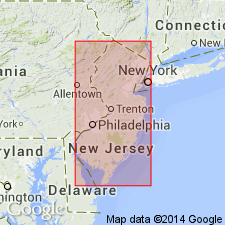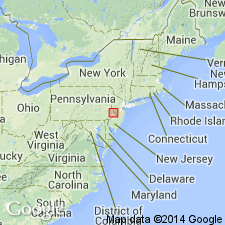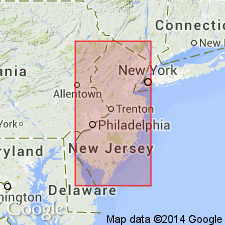
- Usage in publication:
-
- Rickenbach dolomite
- Modifications:
-
- Named
- Dominant lithology:
-
- Dolomite
- AAPG geologic province:
-
- Appalachian basin
Summary:
Name Rickenbach proposed for thick- to thin-bedded fine-grained and coarse-grained dolomite overlying Stonehenge limestone and underlying interbedded limestone and dolomite here referred to as Epler formation. Upper and lower contacts transitional. Consists of two unnamed members, an upper fine-grained and a lower coarse-grained. Total thickness about 580 ft. Type sections for both members given.
Source: GNU records (USGS DDS-6; Reston GNULEX).

- Usage in publication:
-
- Rickenbach Formation
- Modifications:
-
- Overview
- AAPG geologic province:
-
- Appalachian basin
Summary:
Rickenbach consists of a thick- to thin-bedded, light- to medium-dark gray, microcrystalline to coarsely megacrystalline dolomite. Unit was divided by Hobson (1963) into lower and upper unnamed members. Nomenclature followed here is that of Markewicz and Dalton (1977) who divided the unit into a lower unnamed member, the overlying Hope Member, and a distinct facies named the Crooked Swamp dolomite. Lower member is a thin- to medium-bedded, cream to dark-gray weathering dolomite. Pyrite is scattered throughout. Lower member is 75 to 150 ft thick. The gradationally overlying Hope Member is as much as 175 ft thick and consists of light- to medium-gray, gray weathering, aphanitic to finely crystalline, medium-bedded dolomite interbedded with darker gray, dark-gray weathering, more coarsely crystalline, medium- to massive-bedded dolomite. The Hope Member contains several distinctive chert beds. The Hope underlies the Epler Formation. The Crooked Swamp dolomite facies consists of light-gray to medium gray, light-gray weathering, fine- to coarse-grained, euhedral dolomite and is best developed near Crooked Swamp, 1.5 mi north of the town of Lafayette, Sussex Co. At its type locality is 150 to 200 ft thick but thins abruptly to the north and south. As the unit thins, a distinctive conglomerate occurs in the upper Rickenbach and in the basal part of the overlying Epler. Age of the Rickenbach is Early Ordovician.
Source: GNU records (USGS DDS-6; Reston GNULEX).

- Usage in publication:
-
- Rickenbach Dolomite*
- Modifications:
-
- Areal extent
- AAPG geologic province:
-
- Appalachian basin
Summary:
Early Ordovician conodonts confirm occurrence of Rickenbach Dolomite of Beekmantown Group in Bucks Co., PA.
Source: GNU records (USGS DDS-6; Reston GNULEX).

- Usage in publication:
-
- Rickenbach Dolomite*
- Modifications:
-
- Age modified
- AAPG geologic province:
-
- Appalachian basin
Summary:
Age of Rickenbach Dolomite of Beekmantown Group refined to early and middle Ibexian.
Source: GNU records (USGS DDS-6; Reston GNULEX).
For more information, please contact Nancy Stamm, Geologic Names Committee Secretary.
Asterisk (*) indicates published by U.S. Geological Survey authors.
"No current usage" (†) implies that a name has been abandoned or has fallen into disuse. Former usage and, if known, replacement name given in parentheses ( ).
Slash (/) indicates name conflicts with nomenclatural guidelines (CSN, 1933; ACSN, 1961, 1970; NACSN, 1983, 2005, 2021). May be explained within brackets ([ ]).

